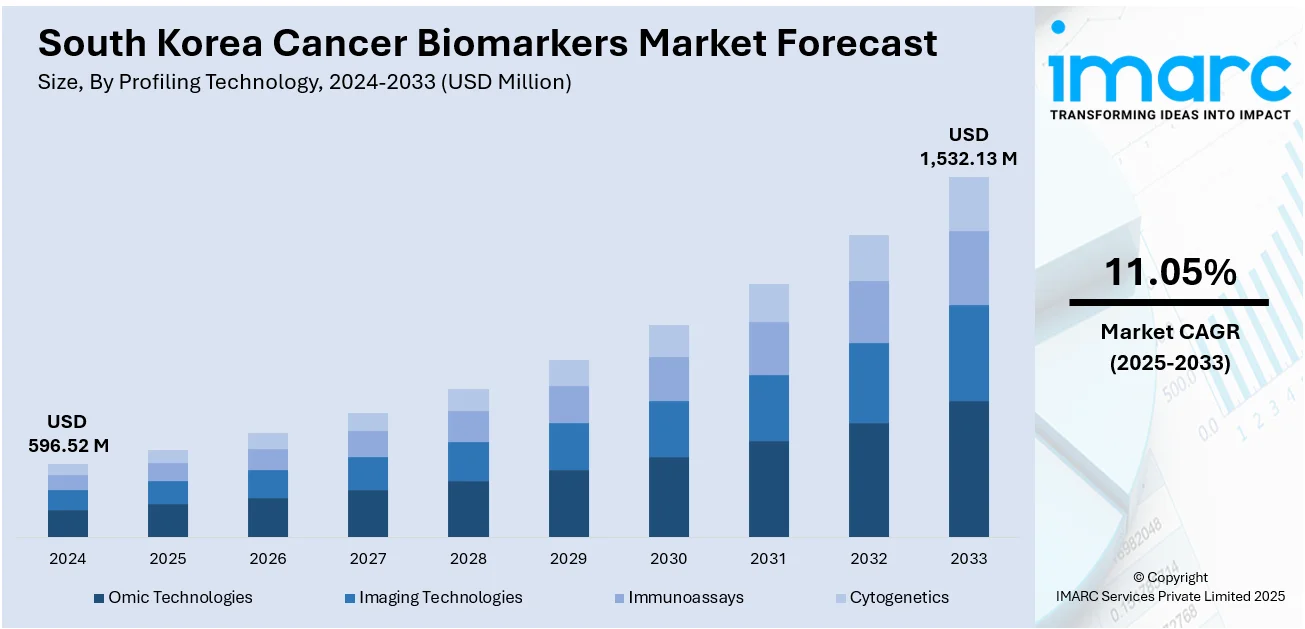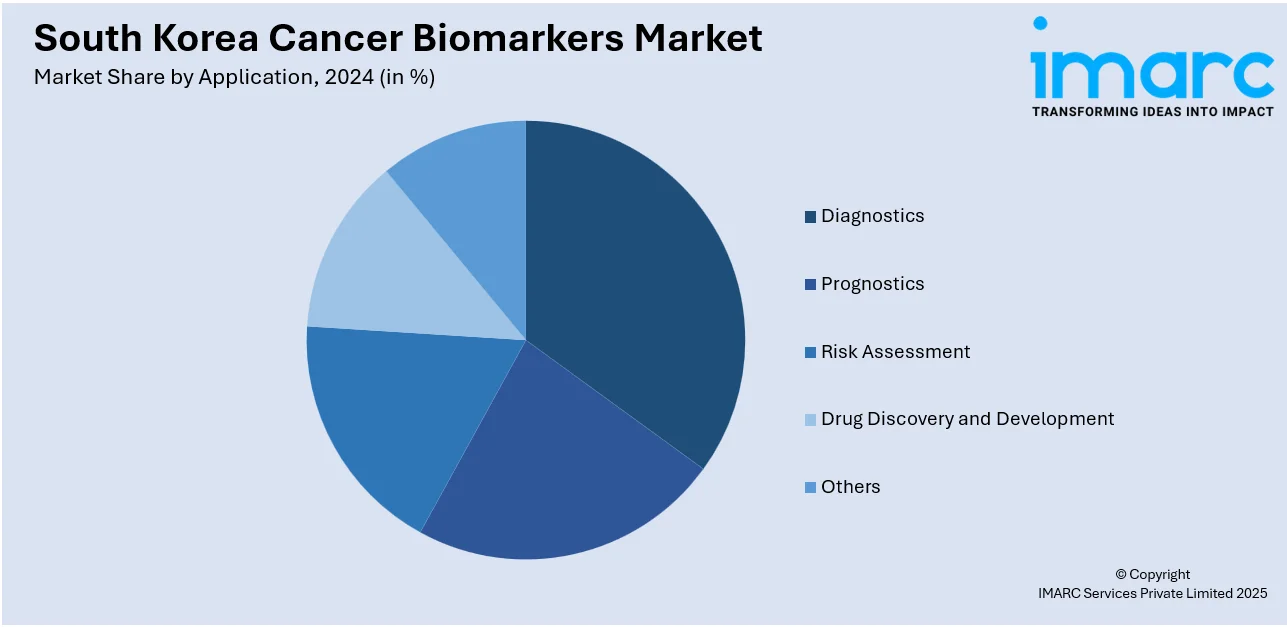
South Korea Cancer Biomarkers Market Size, Share, Trends and Forecast by Profiling Technology, Biomolecule, Cancer Type, Application, End User, and Region, 2025-2033
South Korea Cancer Biomarkers Market Overview:
The South Korea cancer biomarkers market size reached USD 596.52 Million in 2024. The market is projected to reach USD 1,532.13 Million by 2033, exhibiting a growth rate (CAGR) of 11.05% during 2025-2033. The market is fueled by the increasing prevalence of different types of cancer in South Korea, which is creating a higher demand for early diagnosis and precision diagnostics. Besides that, improvements in genomics, proteomics, and high-throughput screening technologies are increasing the reliability and affordability of tests based on cancer biomarkers. Furthermore, encouraging government policies, increasing investments in oncology research, and the wider application of personalized medicine are key drivers augmenting the South Korea cancer biomarkers market share.
|
Report Attribute
|
Key Statistics
|
|---|---|
|
Base Year
|
2024
|
|
Forecast Years
|
2025-2033
|
|
Historical Years
|
2019-2024
|
| Market Size in 2024 | USD 596.52 Million |
| Market Forecast in 2033 | USD 1,532.13 Million |
| Market Growth Rate 2025-2033 | 11.05% |
South Korea Cancer Biomarkers Market Trends:
Increasing Prevalence of Cancer Driving Demand for Early Detection Biomarkers
The rising prevalence of cancer in South Korea is a significant factor that is increasing the demand for biomarker-based diagnostics and monitoring tools. According to industry reports, South Korea recorded approximately 292,221 newly diagnosed cancer cases and 83,770 cancer-related deaths in 2024. Thyroid cancer was the most frequently occurring type, followed by cancers of the colon and rectum, lungs, breast, and stomach. Collectively, these five cancer types account for 55.7% of the country’s total cancer burden. This escalating cancer burden has intensified the need for early detection and precision diagnostic solutions, positioning biomarkers as a critical component of South Korea’s national cancer management strategy. Moreover, biomarkers enable the identification of malignancies at early stages, when treatment outcomes are more favorable, and cost burdens are significantly lower. As a result, healthcare providers are increasingly incorporating biomarker screening into routine health check-ups and cancer surveillance programs. Additionally, patient awareness about preventive screening is growing, which is further supporting the integration of biomarker technologies across both public and private healthcare institutions.

To get more information on this market, Request Sample
Robust Government Support
Government initiatives and public-sector funding play a pivotal role in contributing to the South Korea cancer biomarkers market growth. Additionally, the South Korean government, particularly through the Ministry of Health and Welfare and the Ministry of Science and ICT, is heavily investing in biomedical innovation under its broader strategy to position the country as a global leader in biotechnology. Apart from this, multiple national projects, strategic partnerships, and initiatives are supporting cancer research and prioritizing the development and deployment of advanced diagnostics, including cancer biomarkers. For instance, on November 19, 2024, the U.S. National Cancer Institute (NCI) and South Korea’s National Institute of Food and Drug Safety Evaluation (NIFDS) formalized a memorandum of understanding to enhance international cooperation in cancer research and control. The partnership aims to foster joint initiatives, professional exchanges, and research training programs to advance global cancer prevention, diagnosis, and treatment. Also, dedicated bio-clusters such as the Osong Medical Innovation Foundation offer infrastructure and funding for startups and research labs focused on cancer biomarker development. These initiatives are reinforced by favorable regulatory reforms and streamlined clinical trial approval processes, which are helping accelerate the commercialization and adoption of novel biomarker solutions in clinical settings. This institutional backing significantly enhances innovation capacity and market expansion.
South Korea Cancer Biomarkers Market Segmentation:
IMARC Group provides an analysis of the key trends in each segment of the market, along with forecasts at the country and regional levels 2025-2033. Our report has categorized the market based on profiling technology, biomolecule, cancer type, application, and end user.
Profiling Technology Insights:
- Omic Technologies
- Imaging Technologies
- Immunoassays
- Cytogenetics
The report has provided a detailed breakup and analysis of the market based on the profiling technology. This includes omic technologies, imaging technologies, immunoassays, and cytogenetics.
Biomolecule Insights:
- Genetic Biomarkers
- Protein Biomarkers
- Glyco-Biomarkers
A detailed breakup and analysis of the market based on the biomolecule have also been provided in the report. This includes genetic biomarkers, protein biomarkers, and glyco-biomarkers.
Cancer Type Insights:
- Breast Cancer
- Lung Cancer
- Colorectal Cancer
- Prostate Cancer
- Stomach Cancer
- Others
The report has provided a detailed breakup and analysis of the market based on the cancer type. This includes breast cancer, lung cancer, colorectal cancer, prostate cancer, stomach cancer, and others.
Application Insights:

- Diagnostics
- Prognostics
- Risk Assessment
- Drug Discovery and Development
- Others
A detailed breakup and analysis of the market based on the application have also been provided in the report. This includes diagnostics, prognostics, risk assessment, drug discovery and development, and others.
End User Insights:
- Hospitals
- Academic and Research Institutions
- Ambulatory Surgical Centers
- Diagnostic Laboratories
- Others
The report has provided a detailed breakup and analysis of the market based on the end user. This includes hospitals, academic and research institutions, ambulatory surgical centers, diagnostic laboratories, and others.
Regional Insights:
- Seoul Capital Area
- Yeongnam (Southeastern Region)
- Honam (Southwestern Region)
- Hoseo (Central Region)
- Others
The report has also provided a comprehensive analysis of all the major regional markets, which include Seoul Capital Area, Yeongnam (Southeastern Region), Honam (Southwestern Region), Hoseo (Central Region), and others.
Competitive Landscape:
The market research report has also provided a comprehensive analysis of the competitive landscape. Competitive analysis such as market structure, key player positioning, top winning strategies, competitive dashboard, and company evaluation quadrant has been covered in the report. Also, detailed profiles of all major companies have been provided.
South Korea Cancer Biomarkers Market News:
- On March 31, 2025, South Korea–based Lunit announced a strategic partnership with the U.S. National Cancer Institute (NCI) to advance AI-powered biomarker research. The collaboration involves the application of Lunit’s AI-based analysis tools, Lunit SCOPE® IO and SCOPE Universal IHC, to whole-slide pathology images from NCI’s clinical trials, aiming to enhance the understanding of tumor microenvironments and immune phenotyping. By integrating AI into cancer research workflows, the initiative seeks to generate high-impact insights that support the development of more effective, personalized immunotherapy strategies. Both organizations will co-author publications and reports based on the research outcomes to further contribute to the global oncology community.
- On June 4, 2025, Seer, Inc. and Korea University launched a groundbreaking population-scale proteomics study leveraging Seer’s Proteograph ONE assay and SP200 automation platform to identify novel blood-based biomarkers for early cancer diagnostics in young adults. This three-year initiative is backed by South Korea’s K‑Health MIRAE program, will analyze 20,000 plasma samples using AI-driven mass spectrometry combined with Thermo Scientific’s Orbitrap Astral system. The collaboration aims to accelerate highly sensitive and scalable diagnostic tools, improving early detection and treatment outcomes for cancers in individuals in their 20s and 30s.
South Korea Cancer Biomarkers Market Report Coverage:
| Report Features | Details |
|---|---|
| Base Year of the Analysis | 2024 |
| Historical Period | 2019-2024 |
| Forecast Period | 2025-2033 |
| Units | Million USD |
| Scope of the Report |
Exploration of Historical Trends and Market Outlook, Industry Catalysts and Challenges, Segment-Wise Historical and Future Market Assessment:
|
| Profiling Technologies Covered | Omic Technologies, Imaging Technologies, Immunoassays, Cytogenetics |
| Biomolecules Covered | Genetic Biomarkers, Protein Biomarkers, Glyco-Biomarkers |
| Cancer Types Covered | Breast Cancer, Lung Cancer, Colorectal Cancer, Prostate Cancer, Stomach Cancer, Others |
| Applications Covered | Diagnostics, Prognostics, Risk Assessment, Drug Discovery and Development, Others |
| End Users Covered | Hospitals, Academic and Research Institutions, Ambulatory Surgical Centers, Diagnostic Laboratories, Others |
| Regions Covered | Seoul Capital Area, Yeongnam (Southeastern Region), Honam (Southwestern Region), Hoseo (Central Region), Others |
| Customization Scope | 10% Free Customization |
| Post-Sale Analyst Support | 10-12 Weeks |
| Delivery Format | PDF and Excel through Email (We can also provide the editable version of the report in PPT/Word format on special request) |
Key Questions Answered in This Report:
- How has the South Korea cancer biomarkers market performed so far and how will it perform in the coming years?
- What is the breakup of the South Korea cancer biomarkers market on the basis of profiling technology?
- What is the breakup of the South Korea cancer biomarkers market on the basis of biomolecule?
- What is the breakup of the South Korea cancer biomarkers market on the basis of cancer type?
- What is the breakup of the South Korea cancer biomarkers market on the basis of application?
- What is the breakup of the South Korea cancer biomarkers market on the basis of end user?
- What is the breakup of the South Korea cancer biomarkers market on the basis of region?
- What are the various stages in the value chain of the South Korea cancer biomarkers market?
- What are the key driving factors and challenges in the South Korea cancer biomarkers market?
- What is the structure of the South Korea cancer biomarkers market and who are the key players?
- What is the degree of competition in the South Korea cancer biomarkers market?
Key Benefits for Stakeholders:
- IMARC’s industry report offers a comprehensive quantitative analysis of various market segments, historical and current market trends, market forecasts, and dynamics of the South Korea cancer biomarkers market from 2019-2033.
- The research report provides the latest information on the market drivers, challenges, and opportunities in the South Korea cancer biomarkers market.
- Porter's five forces analysis assist stakeholders in assessing the impact of new entrants, competitive rivalry, supplier power, buyer power, and the threat of substitution. It helps stakeholders to analyze the level of competition within the South Korea cancer biomarkers industry and its attractiveness.
- Competitive landscape allows stakeholders to understand their competitive environment and provides an insight into the current positions of key players in the market.
Need more help?
- Speak to our experienced analysts for insights on the current market scenarios.
- Include additional segments and countries to customize the report as per your requirement.
- Gain an unparalleled competitive advantage in your domain by understanding how to utilize the report and positively impacting your operations and revenue.
- For further assistance, please connect with our analysts.
 Request Customization
Request Customization
 Speak to an Analyst
Speak to an Analyst
 Request Brochure
Request Brochure
 Inquire Before Buying
Inquire Before Buying




.webp)




.webp)












